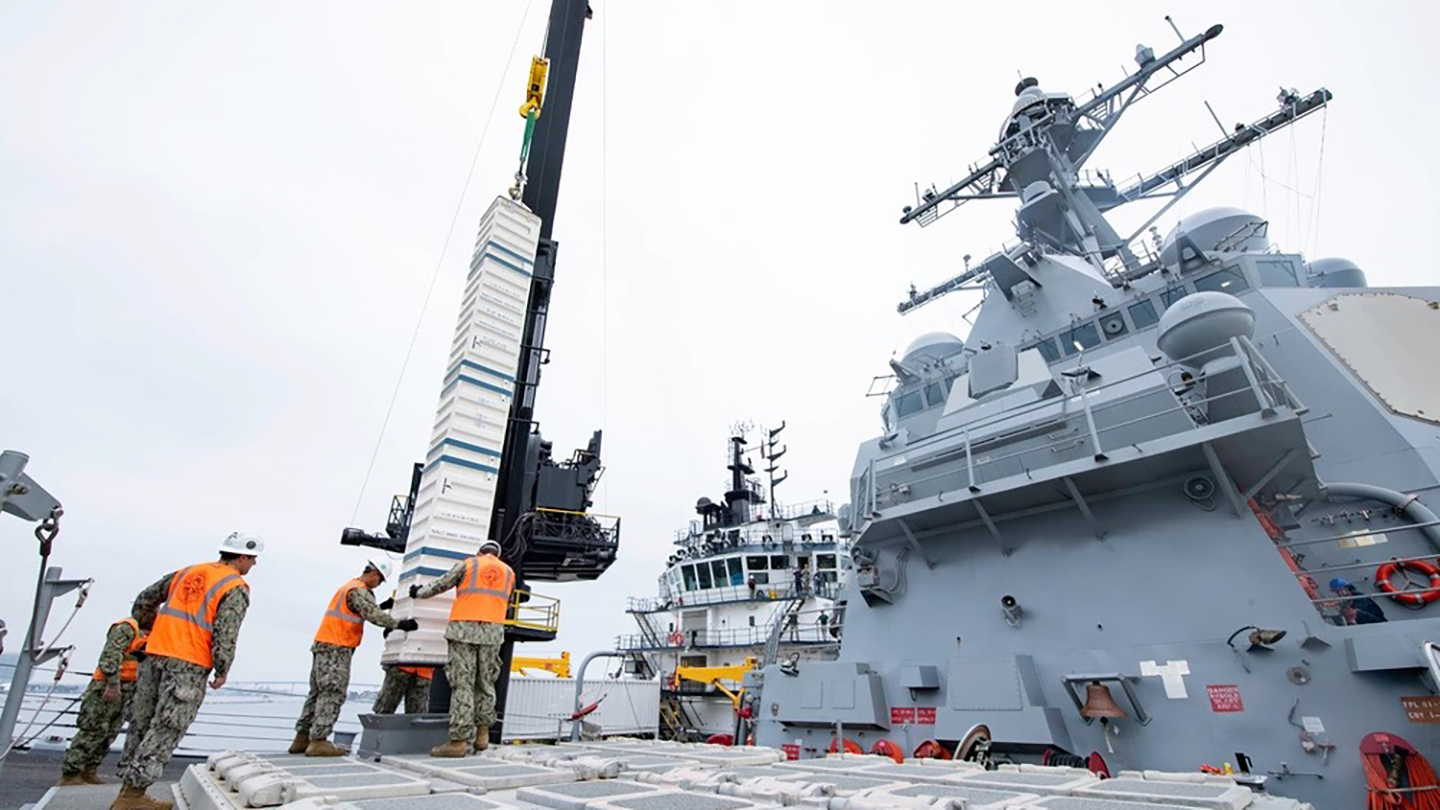With the threat of a conflict in the Pacific looming, a congressional subcommittee says the Navy is not moving fast enough to figure out how to better push munitions to its ships at sea and wants to know what is being done to fix the problem.
This is hardly a new issue, but it has come into sharp focus in the Red Sea as Arleigh Burke class destroyers had fired more than 100 Standard family surface-to-air missiles alone as of mid-February at Houthi missiles and drones. The need to rapidly replenish warships would be far more pronounced in a large-scale fight with China that would occur over a vast, contested battlespace. We explored those challenges and the potential need for more Vertical Launch Systems to deliver those weapons in our deep dive here.

The committee is so concerned about the issue that it ordered the Comptroller General of the United States “to assess the Navy’s efforts to develop a rearm-at-sea capability.”
The review should address:
- The Navy’s current efforts and future plans to develop this capability,
- The Navy’s current and planned technology development investments to achieve this capability, to include planned cost and schedule for these investments;
- Alternative courses of action the Navy is considering to address this capability gap, to include the use of uncrewed technologies.
- Plans to provide a briefing to the House Committee on Armed Services no later than Feb. 15, 2025, on its preliminary findings and submit a final report to the congressional defense committees on a date agreed to at the time of the briefing.
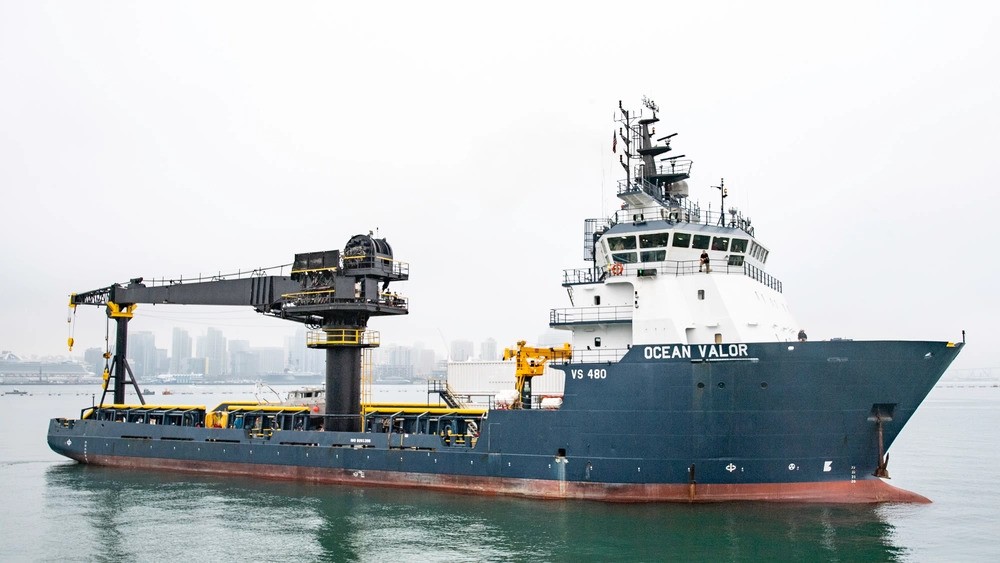
The sea service and its industry partners are “currently engaged in the development, demonstration and testing of various expeditionary reloading options through 2024,” a Navy spokesperson told The War Zone on Wednesday in response to the congressional demands. “Connected-underway reloading capabilities are in the development and testing phase.”
According to figures provided by the Navy, In Fiscal Year 2023, the service allocated $3.9 million in Research, Test, Development & Evaluation (RDT&E) funds for what’s known as the modular Transportable Re-Arming Mechanism (TRAM) system with another $12.4 million set aside for Fiscal Year 2024. It is unclear whether any funds have been requested for Fiscal Year 2025.
TRAM, as it currently exists, is designed to be used in conjunction with existing Navy at-sea replenish ships and will be able to reload Vertical Launch System (VLS) cells on surface ships at up to Sea State 5. The Beaufort Scale defines Sea State 5 as conditions involving moderate winds between 17 and 21 knots and moderate waves between six and eight feet. The system uses an articulated crane that can lift and rotate a missile canister vertically, then lower it into the launcher cell, according to a past report from Naval News.
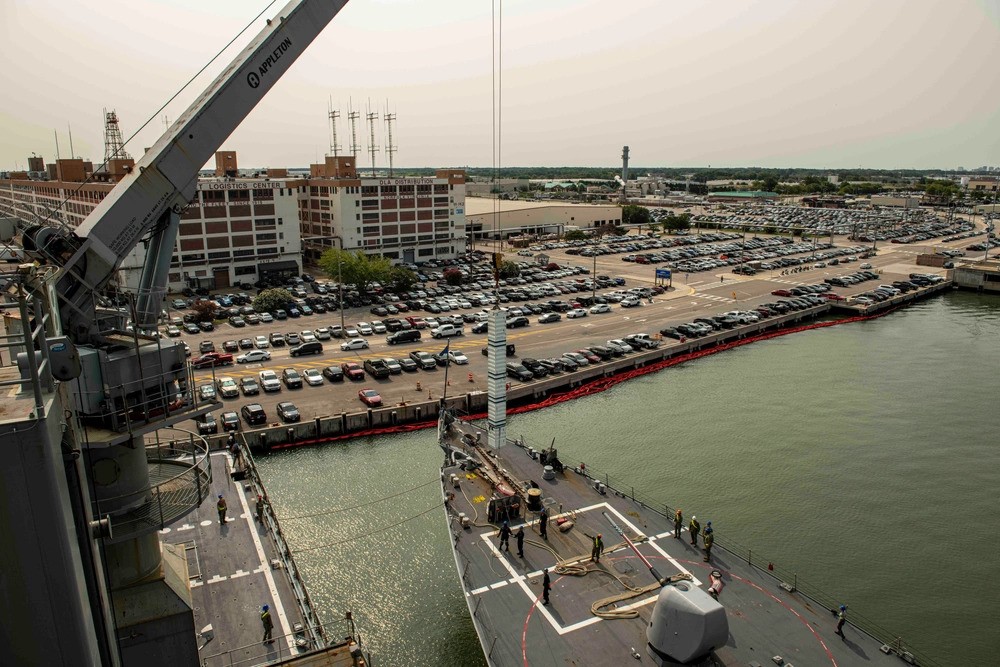
The Navy “has conducted multiple test events demonstrating related capabilities,” the spokesperson told us. That includes an August 2023 pier-side exercise involving Arleigh Burke class destroyer USS Porter (DDG 78) and Military Sealift Command’s (MSC) dry cargo ammunition ship USNS William McLean (T-AKE 12). There was an early demonstration that took place in San Diego in 2022. This is certainly something the Navy has explored on-and-off on multiple occasions.
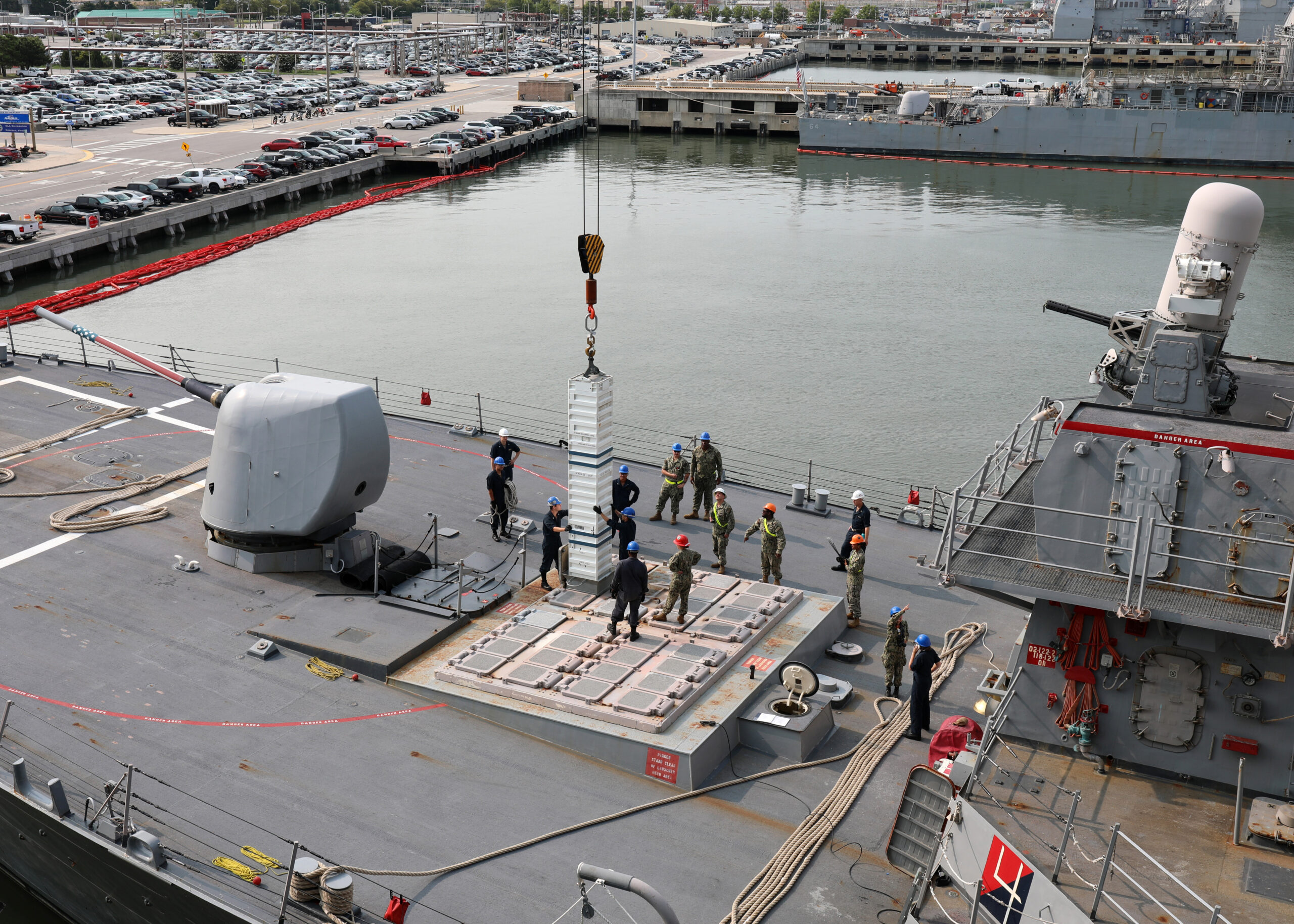
We asked for more details about the Navy’s at-sea reloading testing timeline, reloading options, types of connected-underway reloading capabilities that are being developed and tested as well as future funding requests.
Clearly, there is concern about this issue at the highest levels of the Navy.
“The near-term deterrent effect of fielding TRAM in the Fleet cannot be overstated,” Navy Secretary Carlos Del Toro said at the 36th SNA Symposium. “[This is] a game-changing [capability] that will be operational within two to three years, and will make our surface navy more formidable, serving as a powerful maritime deterrent.”
“This issue about re-arming our destroyers in the Red Sea today is far more relevant, I assure you, than it was a year ago when we first started thinking about this,” Del Toro added.
An at-sea test of the TRAM system is expected this summer, Del Toro said at the time.
As we reported in the past though, “deploying at-sea rearming ships would bring its own risks and additional operational demands. Auxiliary ships equipped with TRAM and loaded with munitions would need escorts to protect them during operations in forward areas. This would likely be a major job for the Constellation class, for instance. Beyond just fixed facilities, logistics chains, in general, are typically major targets for enemy forces in a conflict.”
“We need to acknowledge that we should assume…they’re going to challenge our sustainment,” then-Marine Corps Commandant Gen. David Berger said in 2022 about logistics in a notional future high-conflict with China. “[We need a] real relook at everything from pre-positioning ashore to pre-positioning afloat to the lift that conventionally has gone across the ocean through this solid protected pipeline delivered in some big port.”
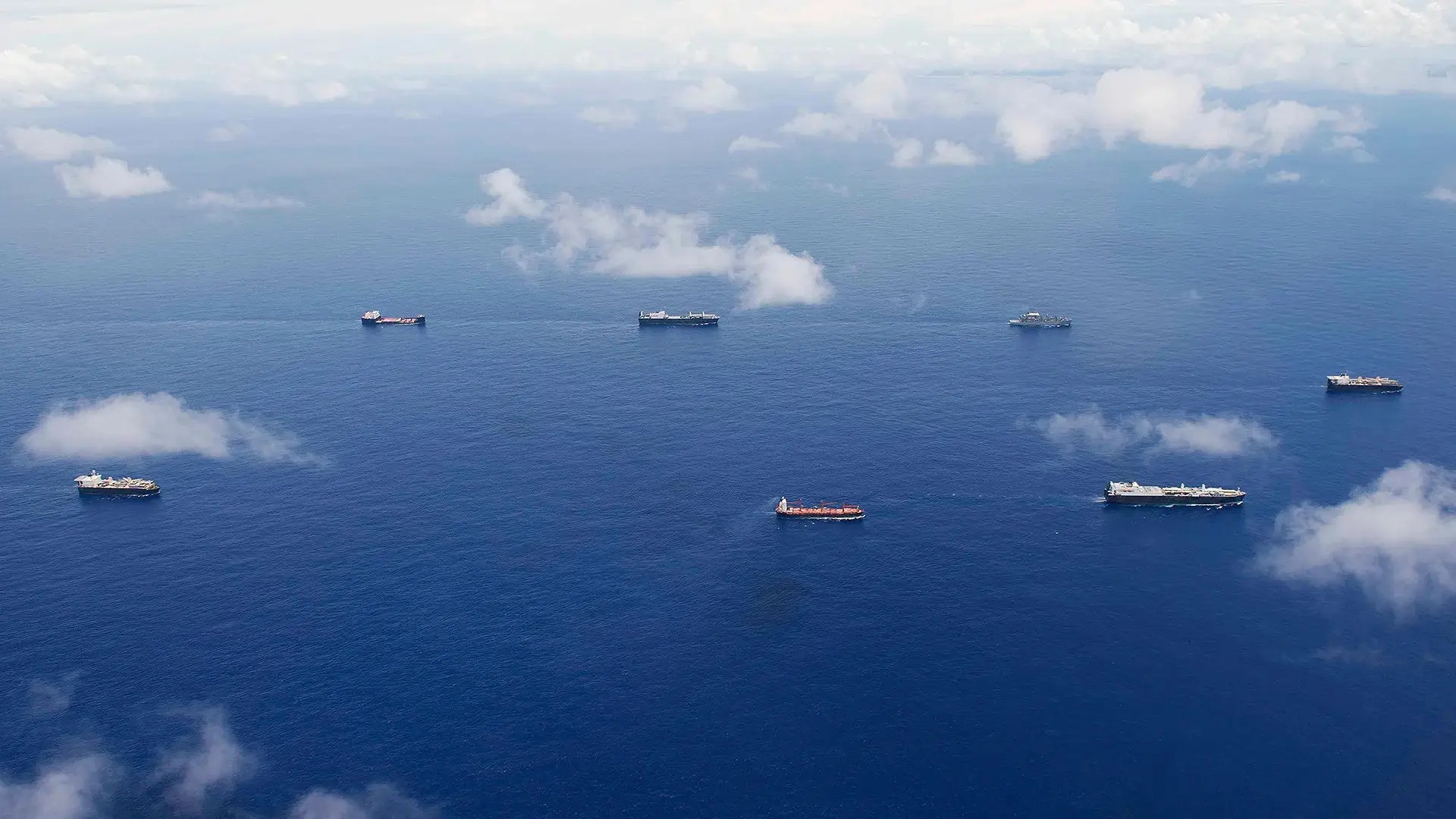
While the U.S. Navy is still waiting to conduct at-sea testing, the French Navy last week carried out its first such transfer in real-world conditions.
“During a replenishment at sea (RAM) conducted between the force supply vessel (BRF) Jacques Chevallier and the aircraft carrier Charles de Gaulle, a transfer and siloing of the Aster [surface-to-air] missile were undertaken for the first time at sea,” the French Defense Ministry announced on May 9.
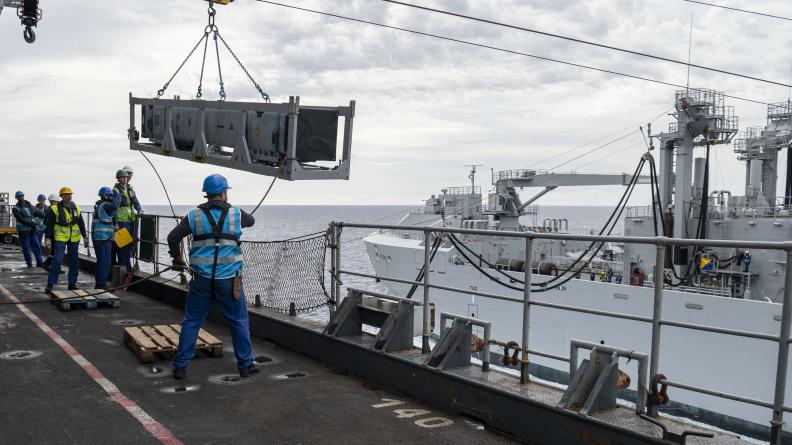
“Successfully carried out, this unprecedented experiment on the reloading capacity of an Aster made it possible to test and validate new know-how for the benefit of the ability of the naval air group to last longer at sea. The latter is thus now able to replenish the aircraft carrier’s stocks of self-defense weapons by avoiding a stopover, which until now was necessary for loading Aster missiles.”
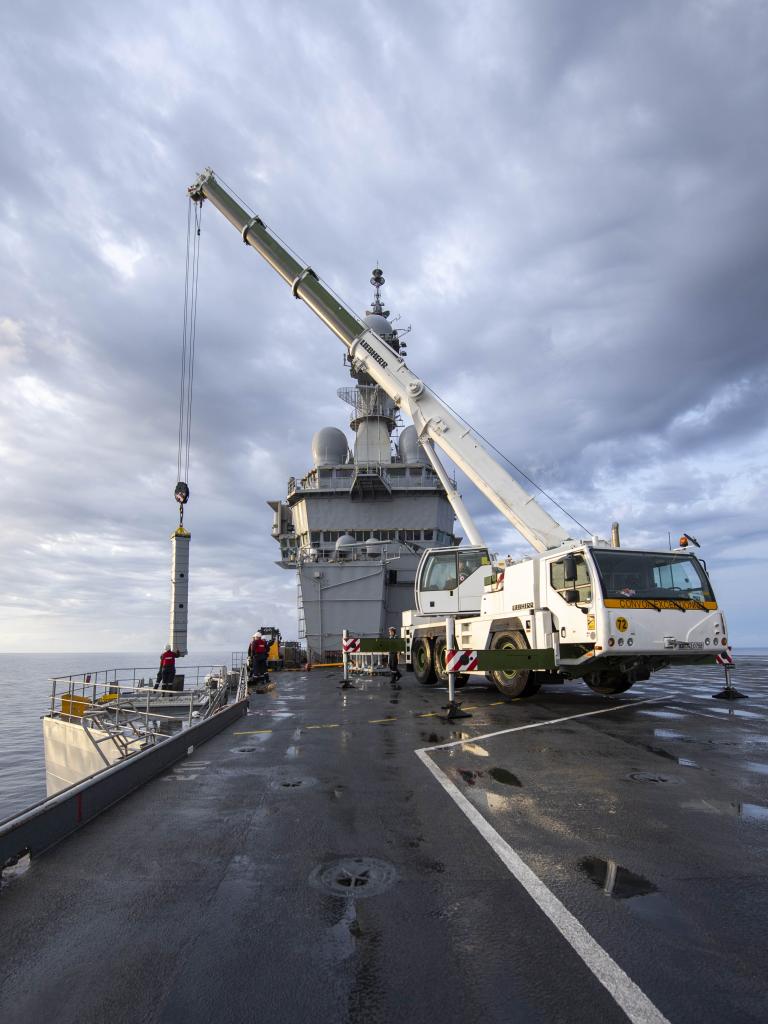
Still, it’s a very different thing reloading VLS cells on an aircraft carrier with a truck-mounted crane on its deck compared to on a surface combatant without the benefits of massive deck space and inherent stability.
French warships have had several engagements against Houthi threats, downing ballistic missiles and drones. The crew of the Aquitaine class frigate Alsace, for instance, called upon “all of the [air defense] combat equipment on board,” its captain said. That included Aster SAMs, the 76mm Super Rapid deck gun — already established as well-capable of downing Houthi drones — and 12.7mm heavy machine guns. You can see a video of that engagement below.
The vast amount of missiles and other ordnance against Houthi threats surprised Navy leadership.
“September of last year, we didn’t know we’re going to be in a fight in the Red Sea and expending the amount of munitions that we’ve expended over the last seven, eight months,” Read Adm. Fred Pyle, Director, Surface Warfare Division, Office of the Chief of Naval Operations said earlier this week during a Center for Strategic & International Studies discussion on lessons learned from Red Sea operations. “So, you know, any assistance we can get there is goodness. But it also drives home the point, and it emphasizes the need, to increase munitions across the board.”

The need to keep Navy vessels armed in a fight will be exponentially more difficult against China than the current battles against the Houthis. Chinese weapons are far more numerous, diverse, far-reaching and sophisticated than those possessed by the Houthis, which could require massive and sustained defensive actions to keep them at bay. The number of potential target sets to attack is also drastically larger than anything the U.S. has dealt with since the end of the Cold War. VLS cells could repeatedly run dry with long voyages back to port needed to reload. Those ports could also be put at risk, further complicating these operations. Just the vastness of the Pacific compounds the logistical challenges and would spread America’s naval force very thin.
It’s one thing to have enough missiles and other munitions. It’s something else to get them to ships at war. Exactly when the Navy improves its ability to do so remains to be seen.
Contact the author: howard@thewarzone.com
